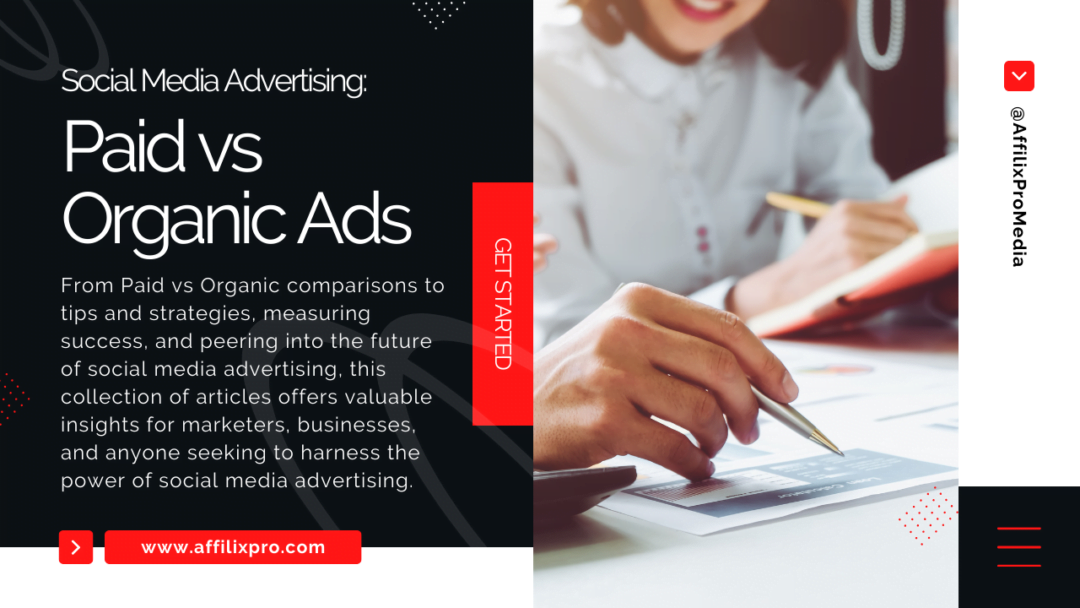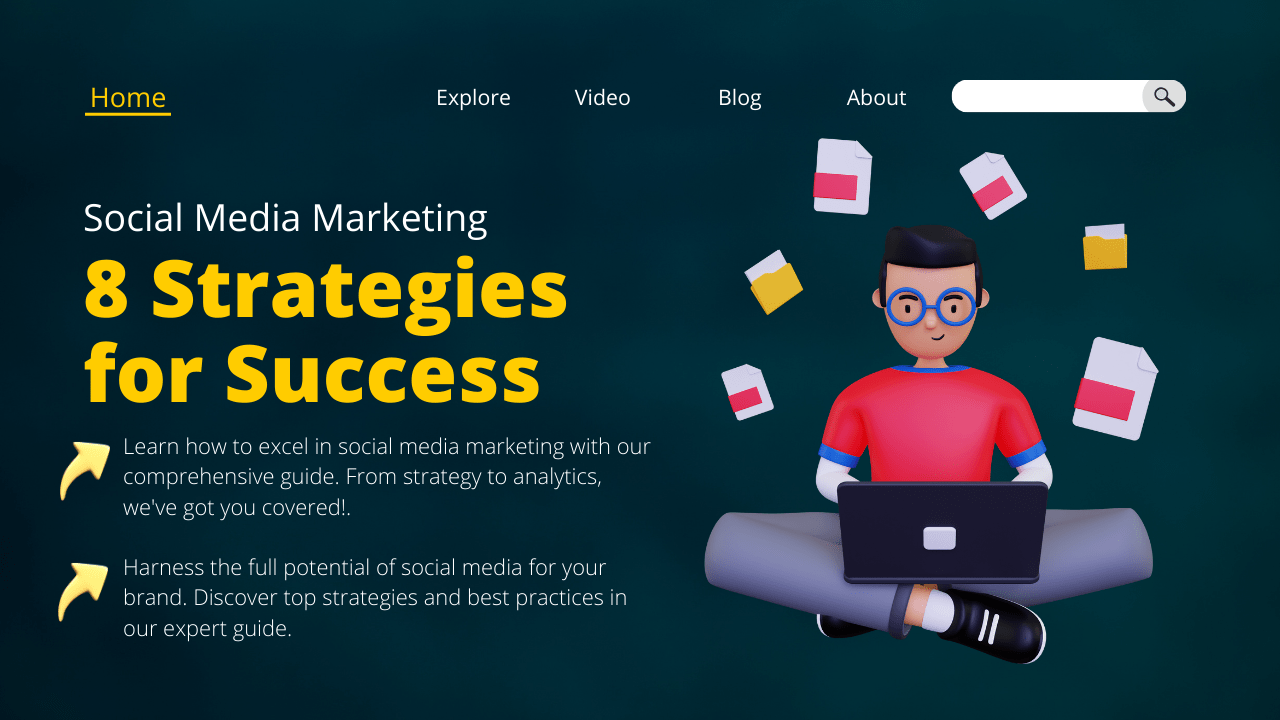Paid vs Organic Ads on Social Media Advertising
Social media advertising has become a vital component of any successful marketing strategy. Businesses and brands, both big and small, are constantly looking for ways to effectively engage with their target audience. One of the key decisions they face is whether to invest in paid advertising or focus on organic efforts.
Paid Social Media Advertising
Paid social media advertising is a powerful tool in the hands of marketers. It involves dedicating a portion of your marketing budget to promote your content or products on various social media platforms. The main distinguishing feature of this approach is that it leverages financial resources to expand your reach, engage your target audience, and drive desired actions.
Organic Social Media Advertising
On the other side of the coin, we have organic social media advertising, a realm where creativity and authenticity take center stage. This approach doesn’t rely on financial investments to boost your online presence; instead, it’s all about crafting content that resonates with your audience and grows naturally.

The Power of Paid Social Media Advertising
In the vast and bustling realm of social media advertising, paid campaigns stand as a dynamic and influential force. This article is dedicated to exploring the first question in-depth, focusing on the immense power and advantages of paid social media advertising.
Targeted Reach: Precision in Promotion
One of the foremost advantages of paid social media advertising is the ability to target your audience with laser-like precision. When you invest in paid campaigns, you gain access to a wealth of data and tools provided by social media platforms. This data encompasses demographics, interests, online behavior, and more. Harnessing this information, you can tailor your ads to reach the very individuals who are most likely to be interested in your products or services.
For instance, if you are marketing a luxury beauty brand, you can set your ads to specifically target women aged 25-45 with a high-income level, an interest in cosmetics, and a history of purchasing skincare products online. This targeted approach ensures that your ad spend is not wasted on a broad audience but is concentrated on those most likely to convert. This precision in promotion is invaluable and can significantly boost your return on investment (ROI).
Immediate Results: Seizing the Moment
In the fast-paced world of digital marketing, timing is often of the essence. There are occasions when you need to capitalize on trends, current events, or market opportunities swiftly. This is where paid social media advertising truly shines.
While organic methods may require time to gain traction and visibility, paid campaigns can deliver immediate results. Whether you’re launching a flash sale, announcing a limited-time offer, or promoting a product tied to a trending topic, paid advertising ensures your message reaches your audience at the right moment. It’s like having a direct line to your potential customers, allowing you to seize the moment and drive quick, targeted actions.
This immediacy can be a game-changer in industries where timing is critical, such as e-commerce, entertainment, or event promotion. It ensures that you don’t miss out on valuable opportunities due to the slower pace of organic growth.
Enhanced Visibility: Standing Out in the Crowd
In the noisy and competitive landscape of social media, standing out is a challenge. Organic posts often have to compete with numerous other content pieces for user attention. Paid advertising, however, provides a solution to this problem.
Paid ads are strategically positioned within users’ social media feeds. Whether it’s on Facebook, Instagram, Twitter, or other platforms, paid content is given a prominent place, making it hard to miss. This enhanced visibility increases the likelihood of user engagement.
Moreover, paid ads often come with distinctive visual elements, such as a “Sponsored” label, eye-catching visuals, and compelling calls to action. These elements are designed to grab users’ attention and encourage them to take the desired actions, whether it’s clicking a link, making a purchase, or signing up for a newsletter.
In essence, paid advertising offers a competitive edge by allowing your content to break through the clutter and be seen by a wider audience. This increased visibility can be a game-changer for businesses looking to create brand recognition and foster engagement.
Analytics and Data: Informed Decision-Making
Paid social media advertising isn’t a blind investment. It’s a data-driven approach that enables you to make informed decisions at every stage of your campaign.
Most social media platforms provide comprehensive analytics tools that allow you to track the performance of your paid campaigns. These tools offer insights into key metrics, including click-through rates (CTR), conversion rates, ad engagement, and more. By examining these metrics, you can evaluate the effectiveness of your ads and make adjustments as needed.
For example, if you find that a particular ad is underperforming in terms of CTR, you can modify its content or targeting to improve results. The ability to make real-time adjustments is a significant advantage of paid advertising. It means that you can continuously refine your campaigns to achieve better outcomes.

The Art of Organic Social Media Advertising
In the realm of social media advertising, organic strategies represent a creative and authentic approach to establishing a robust online presence. This article delves into the art of organic social media advertising, highlighting the significance of this method and providing insights into how it can be harnessed effectively.
Building Trust and Credibility
Organic social media advertising is not just about growing your follower count or increasing engagement; it’s also about fostering trust and credibility among your audience. In a digital landscape saturated with advertisements, authenticity is a rare and precious commodity.
To build trust with your audience, it’s essential to let your brand’s personality shine through. This involves sharing not only your products or services but also your values, culture, and the human side of your brand. Authenticity in your posts, stories, and interactions can set you apart from competitors and make you relatable to your followers.
Frequent engagement with your audience, responding to their comments and messages, and addressing their concerns contribute to trust-building. When your audience sees that you value their input and are genuinely interested in their well-being, they are more likely to trust your brand.
Cost-Effective Strategy
One of the significant advantages of organic social media advertising is its cost-effectiveness. Unlike paid advertising, which requires a budget for ad placements, organic growth relies on creating compelling, shareable content. With the right strategy, you can make the most of your limited budget for content creation.
Content creation is at the heart of organic growth. By producing high-quality content that resonates with your target audience, you can encourage likes, shares, and comments. These interactions not only increase your visibility but also help you build a loyal community around your brand.
For instance, if you are running a small bakery, you can create visually appealing posts of your freshly baked goods, share behind-the-scenes stories of your baking process, and engage with your followers by asking for their favorite pastry recipes. This not only showcases your products but also fosters a sense of community.
The cost of content creation can be significantly lower than paid advertising, making organic methods an attractive choice for businesses with limited budgets.
Content Is King
In the world of organic social media advertising, content is undeniably the king. The success of your organic growth strategy hinges on the quality of the content you produce. Whether it’s blog posts, videos, infographics, or podcasts, the content you create should be engaging, informative, and relevant to your target audience.
The art of creating compelling content involves understanding your audience’s preferences and interests. Researching your target demographic, their pain points, and what they find valuable can provide insights into the type of content that will resonate with them. This can include how-to guides, product showcases, industry insights, or even entertaining and shareable content.
Consistency in content creation is also crucial. Maintaining a regular posting schedule and having a content calendar can help you stay organized and keep your audience engaged. Regular updates ensure that your brand remains on the radar of your followers, fostering a sense of continuity and reliability.
Community Engagement
At the core of organic social media advertising is the notion of community. Building a community around your brand involves engaging with your audience on a personal level, responding to comments, messages, and fostering a sense of belonging.
A strong sense of community can lead to loyal followers who not only support your brand but also advocate for it. Encourage your audience to share their thoughts, experiences, and even user-generated content related to your products or services. This not only boosts engagement but also showcases the real-life value of your brand.
Consider hosting contests, giveaways, or interactive polls to involve your audience actively. These initiatives can create excitement and strengthen the bond between your brand and your followers.

Paid vs Organic – What’s Right for Your Business?
The decision between paid and organic social media advertising is one of the most critical choices that businesses and marketers face. This article aims to tackle the fourth question, which revolves around determining the right approach for your business. It’s essential to understand that there is no one-size-fits-all answer, as the choice depends on various factors, including your business goals, budget, and target audience. Let’s explore the factors that can guide you in making the right decision.
Understanding Your Goals
The first and most crucial step in choosing between paid and organic social media advertising is understanding your business goals. What are you trying to achieve with your social media efforts? Your goals will serve as a compass in guiding your decision.
- Immediate Results: If you have a short-term goal, such as boosting sales during a holiday season or promoting a time-sensitive event, paid advertising might be the better choice. Paid campaigns can provide the immediacy required to meet specific targets quickly.
- Long-Term Growth: If your aim is to build a sustainable online presence and foster long-term relationships with your audience, organic strategies are the way to go. Organic methods focus on creating a loyal community and developing trust over time.
- Lead Generation: If your primary objective is to generate leads for your business, paid advertising can be highly effective. It offers precise targeting and immediate response, making it ideal for lead generation campaigns.
- Brand Awareness: For businesses looking to increase brand awareness and recognition, both paid and organic methods have their merits. Paid ads can provide a quick boost in visibility, while organic content can create a lasting impact.
Budget Considerations
Budget plays a significant role in determining your approach to social media advertising. Consider the financial resources at your disposal and how you want to allocate them.
- Generous Budget: If you have a substantial advertising budget, you can consider a combination of paid and organic strategies. Paid advertising can help you achieve short-term goals, while organic methods can provide lasting benefits.
- Limited Budget: When your budget is constrained, organic social media advertising can be a cost-effective solution. It relies on content creation and community engagement, which can be achieved with minimal financial investment.
- Mid-Range Budget: With a moderate budget, you may have the flexibility to experiment with both paid and organic approaches. It’s important to strike a balance that aligns with your goals and budgetary constraints.
Combining Both Approaches
In some cases, the best approach may involve a combination of both paid and organic strategies. This hybrid approach can leverage the strengths of each method to achieve well-rounded results.
- Strategic Synergy: Paid advertising can be used to boost specific campaigns or promotions, while organic efforts continue to foster long-term engagement and trust.
- Testing and Optimization: Paid campaigns can provide data and insights that inform your organic strategy. By analyzing the performance of paid ads, you can refine your organic content to better resonate with your audience.
- Scaling Up: As your business grows, you can gradually allocate a larger portion of your budget to paid advertising, while still maintaining a strong organic presence.
It’s important to note that the balance between paid and organic methods can evolve over time, depending on your business’s growth and changing objectives. Regular assessment and adaptation of your social media advertising strategy are key to staying competitive and effective in the ever-evolving digital landscape.

Social Media Platforms for Paid Advertising
Selecting the right social media platforms for your paid advertising campaigns is crucial for reaching your target audience effectively. Each platform offers unique strengths, demographics, and user behavior, making it essential to choose wisely. In this article, we will explore several popular social media platforms and discuss their suitability for paid advertising.
Facebook Advertising
Facebook, with its vast user base and robust advertising tools, is a prime choice for paid advertising. It offers diverse ad formats, including image ads, video ads, and carousel ads, allowing you to craft engaging content. Here’s why Facebook advertising is a compelling option:
- Demographic Diversity: Facebook’s user base spans across age groups, making it versatile for targeting different demographics.
- Precise Targeting: Facebook offers granular targeting options, allowing you to select audiences based on interests, behaviors, and demographics.
- Ad Placements: You can display your ads in users’ feeds, on the right column, in Messenger, or within the Audience Network, providing ample exposure opportunities.
- Robust Analytics: Facebook provides comprehensive analytics and insights, enabling you to assess your ad performance and make data-driven decisions.
Instagram Advertising
Owned by Facebook, Instagram is a visual platform that’s particularly effective for businesses with highly visual products or services. Here’s why Instagram advertising is compelling:
- Visual Appeal: Instagram’s focus on visuals makes it ideal for showcasing products, services, and lifestyle content.
- Engagement: The platform boasts high engagement rates, with users often interacting with posts through likes, comments, and shares.
- Story Ads: Instagram Stories offer an immersive ad experience, with full-screen vertical ads that can be interactive and engaging.
- Audience Overlap: You can leverage Facebook’s ad targeting options to reach Instagram users, allowing for cross-platform campaigns.
Twitter Advertising
Twitter is known for real-time engagement, making it suitable for certain industries and marketing campaigns. Here’s why Twitter advertising is a compelling option:
- Real-Time Marketing: Twitter is a platform where trending topics and real-time conversations are prevalent. This makes it excellent for timely promotions and updates.
- Promoted Tweets: You can use promoted tweets to push specific content or announcements to a broader audience.
- Follower Targeting: Twitter allows you to target users based on interests, keywords, and follower demographics.
- Engagement Analytics: In-depth engagement metrics help you gauge the effectiveness of your campaigns and optimize your strategy.
LinkedIn Advertising
LinkedIn is the go-to platform for B2B (business-to-business) marketing, making it suitable for businesses targeting a professional audience. Here’s why LinkedIn advertising is a compelling option:
- Professional Network: LinkedIn is where professionals and businesses connect, making it ideal for B2B marketing efforts.
- Sponsored Content: You can promote sponsored content in users’ feeds, reaching professionals who are likely interested in industry-specific information.
- InMail Ads: InMail ads allow you to send personalized messages to users’ inboxes, which can be effective for lead generation and networking.
- Precise Targeting: LinkedIn offers detailed targeting options, including job titles, company size, industry, and more.
Pinterest Advertising
Pinterest is a visually driven platform that excels in inspiring users to discover and explore new ideas. Here’s why Pinterest advertising is a compelling option:
- Visual Discovery: Pinterest is all about visual discovery, and its users often seek inspiration for various projects and interests.
- Promoted Pins: You can use promoted pins to amplify your brand’s visibility and reach users who are actively searching for products and ideas.
- Shopping Ads: Pinterest offers shopping ads, allowing users to shop directly through your pins, making it suitable for e-commerce businesses.
- Rich Pins: Rich pins enable you to provide more information, such as product details, recipes, and articles, within your pins.
Each of these social media platforms has its strengths and is suitable for different businesses and objectives. When planning your paid advertising campaigns, it’s essential to consider your target audience, the nature of your products or services, and your marketing goals. A well-thought-out strategy that aligns with the platform’s features and user behavior can lead to successful paid advertising campaigns. In the upcoming articles, we will delve into strategies and best practices for making the most of these platforms for your paid advertising efforts.

Paid Social Media Advertising – Tips and Strategies
Paid social media advertising is a powerful tool for reaching and engaging your target audience. However, to make the most of your advertising budget and achieve your marketing goals, you need effective strategies and best practices. In this article, we will delve into key tips and strategies for successful paid social media advertising.
1. Crafting Compelling Ad Copy
The effectiveness of your paid ad largely depends on the ad copy. Whether it’s a Facebook ad, Instagram ad, Twitter ad, or any other platform, the copy needs to be persuasive and concise. Here are some tips for crafting compelling ad copy:
- Clear and Concise: Keep your message clear and concise. Users should understand your offer or message in a matter of seconds.
- Use Action Words: Incorporate action words that encourage users to take action, such as “shop now,” “learn more,” or “get started.”
- Highlight Benefits: Focus on the benefits users will gain from your product or service. What problem does it solve, and how does it improve their lives?
- Create a Sense of Urgency: Utilize words like “limited time offer” or “act now” to create a sense of urgency and prompt immediate action.
- Tailor Copy to the Platform: Customize your ad copy to the platform you’re using. What works on Facebook might not work on Twitter. Consider platform-specific best practices.
2. A/B Testing
A/B testing (or split testing) is a powerful method for optimizing your paid ad campaigns. It involves creating two versions of an ad with slight variations and testing them to see which one performs better. Here’s how to make the most of A/B testing:
- Test Different Elements: You can test various elements, including headlines, ad copy, visuals, and calls to action.
- Monitor Performance Metrics: Keep a close eye on key performance metrics such as click-through rate (CTR), conversion rate, and engagement to determine the winning ad.
- Iterate and Refine: Based on the results, iterate and refine your ads. Continue testing to improve campaign performance over time.
3. Ad Scheduling
The timing of your ad placements can significantly impact their effectiveness. Consider your target audience’s time zone, behavior, and habits. Here’s how to use ad scheduling to your advantage:
- Analyze Data: Review historical data to identify when your target audience is most active on the platform. Peak activity times can vary by platform.
- Schedule for Peak Engagement: Schedule your ads to run during times of peak user engagement to maximize visibility and interaction.
- Dayparting: Consider dayparting, which involves showing ads at specific times of the day or on specific days of the week. This can be useful for promotions and events.
4. Budget Management
Managing your advertising budget effectively is crucial to prevent overspending and ensure a positive return on investment (ROI). Here are some strategies for budget management:
- Set a Daily or Lifetime Budget: Most platforms allow you to set either a daily or lifetime budget. Determine which option aligns with your campaign goals and monitor spending.
- Bid Strategies: Understand the bidding options available on the platform. You can choose automatic or manual bidding, depending on your strategy.
- Adjust and Optimize: Regularly assess your ad performance and adjust your budget based on what’s working. Allocate more budget to high-performing ads and campaigns.
- Bid Cap: Set a bid cap to control the maximum amount you’re willing to pay for clicks or impressions. This prevents unexpected overspending.
5. Audience Targeting
Precise audience targeting is a cornerstone of effective paid advertising. It ensures that your ads reach the people most likely to be interested in your product or service. Consider these audience targeting strategies:
- Use Custom Audiences: Many platforms allow you to upload your customer list and create custom audiences. Targeting existing customers can lead to higher conversion rates.
- Lookalike Audiences: Create lookalike audiences based on your existing customers. These are users who share characteristics with your current customers.
- Interest-Based Targeting: Explore interest-based targeting to reach users with specific interests, hobbies, or behaviors related to your offering.
- Demographics and Location: Tailor your audience based on demographics such as age, gender, location, and other relevant factors.
6. Ad Format Optimization
Different ad formats work better for different objectives. Experiment with various formats to see which aligns best with your campaign goals. Here are some common ad formats and their uses:
- Image Ads: Suitable for showcasing products or visuals that can grab the audience’s attention.
- Video Ads: Ideal for storytelling, demonstrating a product in action, or conveying a message visually.
- Carousel Ads: Use these for displaying multiple products or showcasing a step-by-step process.
- Collection Ads: These are designed for mobile shopping experiences and encourage product discovery.
- Story Ads: Great for creating immersive, full-screen experiences that engage users.
Paid social media advertising can be highly effective when approached with the right strategies and best practices. Craft compelling ad copy, engage in A/B testing, schedule your ads strategically, manage your budget wisely

Organic Social Media Advertising – Strategies for Growth
Organic social media advertising offers a unique approach to growing your online presence, fostering authentic connections, and building trust with your audience. In this article, we’ll explore effective strategies for organic growth on social media platforms.
1. Content Calendar and Consistency
Consistency is key to organic growth on social media. Develop a content calendar that outlines when and what type of content you’ll post. This ensures that your audience can anticipate and engage with your content regularly.
- Plan in Advance: Create content themes for each month or week, and plan your posts accordingly. This prevents last-minute scrambling for content ideas.
- Diverse Content: Mix up your content with a variety of formats, such as text posts, images, videos, and stories. Diverse content keeps your audience engaged and interested.
- Posting Schedule: Determine the best times to post based on your audience’s behavior and time zone. Use social media scheduling tools to automate posts at optimal times.
2. Audience Engagement
Engaging with your audience is a fundamental aspect of organic growth. Responding to comments, messages, and participating in conversations fosters a sense of community and loyalty.
- Prompt Responses: Aim to respond to comments and messages promptly. Quick responses show that you value your audience’s input.
- Ask Questions: Encourage interaction by asking questions or seeking opinions from your audience. This not only engages users but also provides valuable insights.
- User-Generated Content: Share user-generated content and give credit to your followers. This not only acknowledges their contributions but also inspires others to participate.
3. Content Optimization
To improve your organic reach, it’s crucial to optimize your content for each social media platform. Each platform has its own best practices and features.
- Hashtags: Use relevant hashtags to increase the discoverability of your posts. Research popular and trending hashtags in your niche.
- Tagging and Mentions: Tag relevant users or brands in your posts and encourage them to engage with your content.
- Keyword Research: Incorporate relevant keywords into your posts and profiles. This helps your content appear in search results on platforms like Instagram and Pinterest.
- Visual Appeal: Ensure your visuals are high-quality and eye-catching. Invest in graphic design or photography if necessary.
4. Storytelling
Effective storytelling can captivate your audience and make your brand more relatable. Share stories about your journey, experiences, or the human side of your business.
- Behind-the-Scenes: Offer a glimpse behind the scenes of your operations. This humanizes your brand and creates a personal connection with your audience.
- Customer Stories: Share success stories or testimonials from satisfied customers. These provide social proof and build trust.
- Narrative Arcs: Craft narratives that span multiple posts or stories. Users are more likely to engage when they’re invested in a narrative.
5. Influencer Collaborations
Leveraging influencer marketing can extend your organic reach by tapping into the influencer’s existing audience. Collaborate with influencers in your niche who align with your brand.
- Research Influencers: Choose influencers whose values and audience align with your brand. Conduct thorough research to ensure authenticity.
- Co-Created Content: Work with influencers to co-create content. This can include sponsored posts, reviews, or influencer takeovers of your social media accounts.
- Promotions and Giveaways: Collaborate with influencers for promotions or giveaways. This can rapidly increase your visibility and following.
6. Analyze and Adjust
To maximize your organic growth efforts, regularly monitor your performance and make adjustments based on the data. Each platform provides analytics tools for this purpose.
- Performance Metrics: Track key performance metrics such as engagement rates, reach, and click-through rates. Identify what types of content perform best.
- Audience Insights: Review audience demographics and behaviors to refine your targeting and content strategy.
- Testing and Iteration: Experiment with different content types, posting times, and strategies. Use A/B testing to refine your approach.
7. Collaborations and Partnerships
Collaborating with other brands or organizations in your niche can expand your reach. Consider joint promotions, co-hosted events, or content collaborations.
- Cross-Promotion: Share each other’s content or products on your respective social media accounts. This exposes your brand to a new audience.
- Co-Branded Campaigns: Develop co-branded campaigns or events that highlight both brands. This can create buzz and excitement.
- Community Engagement: Engage with other businesses or organizations in your community to foster a sense of local community and support.

Measuring Success in Paid Advertising
Measuring the success of your paid advertising campaigns is a critical aspect of your digital marketing strategy. It allows you to understand the impact of your efforts, make data-driven decisions, and optimize your future campaigns. In this article, we will explore key metrics and methods for measuring success in paid advertising.
1. Key Performance Indicators (KPIs)
To measure the success of your paid advertising campaigns effectively, it’s essential to identify and track the most relevant key performance indicators (KPIs). These KPIs provide insights into the performance of your ads and whether they align with your campaign goals. Common KPIs include:
- Click-Through Rate (CTR): CTR measures the percentage of users who click on your ad after seeing it. A high CTR indicates that your ad is compelling and resonates with your target audience.
- Conversion Rate: The conversion rate measures the percentage of users who take the desired action after clicking on your ad. This action could be making a purchase, signing up for a newsletter, or filling out a contact form.
- Return on Investment (ROI): ROI quantifies the profitability of your paid advertising efforts. It compares the revenue generated from your ad campaign to the total cost of running the campaign.
- Cost Per Click (CPC): CPC represents the average cost you pay for each click on your ad. It’s a crucial metric for budget management and cost-efficiency.
- Quality Score: Quality Score is a metric used by platforms like Google Ads to assess the quality and relevance of your ads. A higher Quality Score can lead to lower costs and better ad placements.
- Ad Position: Ad position indicates where your ad appears on the search results page or within a social media feed. It’s vital for understanding the visibility of your ads.
2. Conversion Tracking
Tracking conversions is essential for understanding the impact of your paid advertising campaigns on your business objectives. To set up conversion tracking:
- Define Conversions: Clearly define what actions you consider as conversions. These can include purchases, form submissions, phone calls, or any other user action that aligns with your goals.
- Implement Tracking Codes: Most advertising platforms provide tracking codes or tags that you need to add to your website. These codes track user interactions and attribute them to specific ads.
- Analyze Data: Regularly analyze conversion data to assess which ads and campaigns are driving the most valuable actions. This allows you to allocate budget and resources effectively.
3. Return on Ad Spend (ROAS)
ROAS is a critical metric for e-commerce businesses and retailers. It measures the revenue generated for every dollar spent on advertising. The formula for calculating ROAS is:
ROAS = Revenue from Ads / Cost of Ads
A ROAS of 1:1 means you are breaking even, while a ROAS greater than 1 indicates a positive return on your ad spend.
4. Click-Through and Conversion Funnel Analysis
Understanding the user journey from clicking on your ad to conversion is crucial. Analyze the funnel to identify potential drop-off points and areas for improvement. Consider using tools like Google Analytics to track the entire user journey, from the initial ad click to the final conversion.
5. Ad Position and Quality Score
For search engine advertising, ad position and Quality Score are pivotal. A higher ad position often leads to more visibility and clicks, while a better Quality Score can reduce costs and improve ad placement. Regularly monitor and optimize both factors to maximize your campaign’s performance.
6. Ad Scheduling and Dayparting Analysis
If you’re running time-sensitive campaigns or promotions, analyzing ad scheduling and dayparting data is vital. It helps you identify the times and days when your ads perform best and allows you to allocate budget strategically.
7. Ad Copy and Creative Performance
Analyze the performance of different ad copies and creatives. Identify which messaging and visuals resonate with your audience. A/B testing can provide valuable insights into what elements of your ad are most effective.
8. Audience Segmentation
Dive into audience data to understand which segments perform best. This allows you to tailor your ad campaigns to specific demographics, behaviors, or interests.
9. Ad Placement and Platform Analysis
If you’re running ads on multiple platforms or across various ad placements within a platform, assess the performance on each. Determine where you’re getting the best results and allocate your budget accordingly.
10. Return on Investment (ROI) Analysis
ROI is the ultimate metric for measuring success in paid advertising. Calculate the revenue generated from your ad campaigns and compare it to the overall cost. A positive ROI indicates that your advertising efforts are profitable and contributing to your business’s bottom line.
Measuring success in paid advertising is essential for optimizing your campaigns and maximizing your return on investment. By tracking relevant KPIs, implementing conversion tracking, and analyzing user behavior and engagement, you can make data-driven decisions that lead to more effective and profitable advertising campaigns. Regularly monitor and adjust your strategies to ensure that your paid advertising efforts continue to deliver the desired results.

Measuring Success in Organic Advertising
Measuring the success of your organic advertising efforts is crucial for understanding the impact of your content and engagement strategies. It allows you to assess your brand’s visibility, audience growth, and overall effectiveness in building a thriving online community. In this article, we will explore key metrics and methods for measuring success in organic advertising.
1. Follower Growth
One of the primary indicators of organic advertising success is the growth of your follower or subscriber base on social media platforms, blogs, or other channels. A steadily increasing follower count signifies that your content is resonating with your target audience.
- Follower Growth Rate: Calculate the monthly or quarterly percentage increase in your follower count to assess the effectiveness of your content and engagement strategies.
- Quality of Followers: While quantity is essential, also focus on the quality of your followers. Look for active and engaged users who genuinely connect with your brand.
2. Engagement Metrics
Engagement metrics are valuable indicators of how well your audience is interacting with your content. These metrics include likes, comments, shares, and other forms of user engagement.
- Engagement Rate: Calculate the engagement rate by dividing the total engagements (likes, comments, shares, etc.) by your total follower count and multiplying by 100. This provides a percentage that measures the level of audience interaction.
- Comments and Conversations: In-depth conversations within the comments section of your posts can indicate a highly engaged and involved audience. Monitor the quality and depth of these interactions.
- Shareability: The number of times your content is shared is a powerful indicator of its quality and relevance. Keep an eye on which content gets shared the most.
3. Reach and Impressions
The reach and impressions metrics provide insights into how many people have seen your content.
- Reach: Reach measures the total number of unique users who have seen your content. It reflects the extent of your content’s exposure.
- Impressions: Impressions represent the total number of times your content has been viewed, including multiple views by the same user. It shows the overall visibility of your content.
4. Click-Through Rate (CTR)
CTR measures the percentage of users who clicked on a link or call-to-action in your content. It’s particularly relevant for blogs and social media posts that include links to your website or landing pages.
- CTR Formula: Calculate CTR by dividing the number of clicks by the total number of times the link or CTA was shown (impressions) and multiplying by 100.
5. Content Performance
Analyze the performance of your content to understand which types and topics resonate with your audience.
- Top-Performing Content: Identify your most popular and engaging content, whether it’s blog posts, videos, infographics, or social media updates.
- Content Shares: Determine which pieces of content are shared the most, as this can indicate the value and relevance of the content to your audience.
- User-Generated Content (UGC): Encourage and track UGC related to your brand or products. UGC often reflects strong community engagement.
6. Website Traffic and Conversions
Organic advertising often aims to drive traffic to your website or landing pages. Monitor your website analytics to assess the impact of your content on visitor traffic and conversion rates.
- Website Traffic: Measure the increase in website traffic resulting from your organic advertising efforts. Tools like Google Analytics can provide detailed insights.
- Conversion Tracking: If your goal is to generate leads or sales, track the number of conversions originating from your organic content.
- Bounce Rate: Analyze the bounce rate to understand how effectively your content retains visitors. A lower bounce rate indicates that visitors are finding valuable content on your website.
7. Search Engine Rankings
For organic advertising that involves SEO efforts, tracking search engine rankings is crucial. Improved rankings for targeted keywords can lead to increased organic traffic.
- Keyword Rankings: Monitor the rankings of your target keywords in search engine results pages. Tools like Google Search Console can help with this.
- Organic Search Traffic: Assess the volume of organic search traffic driven by your keyword optimization efforts.
- Click-Through from Search: Analyze the CTR for organic search results to understand how compelling your titles and meta descriptions are.
8. Return on Investment (ROI)
Calculating the ROI of your organic advertising efforts involves determining the revenue generated from your campaigns compared to the resources invested.
- ROI Formula: Calculate ROI by subtracting the total cost of your organic advertising efforts from the total revenue generated and dividing the result by the total cost, then multiplying by 100.
A positive ROI indicates that your organic advertising efforts are contributing to your business’s profitability.
9. Audience Insights and Surveys
Collect feedback from your audience to gain deeper insights into their preferences, needs, and perceptions.
- Surveys: Conduct audience surveys to gather direct feedback on your content and how it can be improved.
- Social Listening: Use social listening tools to monitor conversations about your brand or industry. This can provide valuable insights into audience sentiment.
- Audience Segmentation: Segment your audience based on demographics, behavior, and interests to tailor your content more effectively.
10. Community Building and Loyalty
Assess the sense of community and loyalty that your organic advertising efforts have cultivated.
- Community Growth: Measure the growth of your online community, whether it’s a social media following or a blog subscriber base.
- Loyalty Metrics: Analyze metrics related to customer loyalty, such as repeat purchases, returning visitors, and brand advocacy.
Measuring success in organic advertising involves tracking various metrics related to follower growth, engagement, reach, content performance, website traffic, SEO rankings, ROI, and audience insights. Regularly monitor these metrics to assess the effectiveness of your organic advertising strategies and make data-driven decisions to optimize your future efforts. Building a thriving online community and fostering brand loyalty are long-term goals that require consistent effort and assessment.

The Future of Social Media Advertising
The landscape of social media advertising is constantly evolving as technology, user behavior, and platform features change. To stay ahead in this dynamic field, it’s essential to anticipate and adapt to future trends and innovations. In this article, we will explore the future of social media advertising and the emerging trends that will shape the industry.
1. Augmented Reality (AR) and Virtual Reality (VR)
Augmented reality and virtual reality are poised to revolutionize the way social media users engage with content and brands. AR filters and VR experiences will become integral to advertising, offering immersive and interactive brand experiences. Users will be able to try on products virtually or explore branded spaces through VR.
- Example: Imagine a fashion brand that allows users to virtually try on outfits using an AR filter on a social media platform, offering a new level of engagement and shopping experience.
2. Artificial Intelligence (AI) and Machine Learning
AI and machine learning are already impacting social media advertising by optimizing ad targeting and content recommendations. In the future, AI will play a more significant role in automating ad creation, personalizing user experiences, and even predicting user behavior.
- Example: AI algorithms will analyze user data to predict the type of content users are most likely to engage with, enabling brands to deliver highly personalized content.
3. User-Generated Content (UGC) and Advocacy
User-generated content will continue to gain prominence as a trusted source of information and recommendations. Brands will encourage and leverage UGC to build authenticity and credibility. User advocates will play a pivotal role in promoting brands to their followers.
- Example: Brands will run campaigns encouraging users to share their experiences with products or services, and user advocates will be rewarded for their contributions.
4. Ephemeral Content
Ephemeral content, such as stories on platforms like Instagram and Snapchat, will remain a vital part of social media advertising. These short-lived posts create a sense of urgency and authenticity, driving engagement and user interest.
- Example: Brands will use stories for flash sales, behind-the-scenes glimpses, and time-sensitive promotions to captivate their audience.
5. Video Dominance
Video content will continue to dominate social media advertising. Short-form videos, live streaming, and interactive video ads will become the norm. Platforms will offer more advanced video editing tools for brands to create compelling content.
- Example: Brands will leverage live video to host Q&A sessions, product launches, and interactive events to connect with their audience in real-time.
6. Social Commerce
The integration of e-commerce directly into social media platforms will expand. Users will be able to shop seamlessly within their favorite apps, from discovering products to completing purchases without leaving the platform.
- Example: A user scrolling through Instagram will have the option to click on a product featured in an ad and make a purchase without exiting the app.
7. Voice Search and Voice Assistants
Voice search is gaining traction, and voice assistants like Siri, Alexa, and Google Assistant are becoming integral to our daily lives. Optimizing content for voice search and leveraging voice-activated ads will be essential for brands.
- Example: Users will use voice commands to search for products or services, and brands can create voice-optimized content to capture these queries.
8. Privacy and Data Protection
As concerns over data privacy grow, social media platforms and advertisers will face increasing scrutiny. Regulations like GDPR and CCPA are likely to set a precedent for data protection, forcing brands to be more transparent and responsible with user data.
- Example: Advertisers will need to obtain explicit consent for data usage, and users will have more control over how their data is collected and utilized for advertising.
9. Micro-Moments and Personalization
Micro-moments are instances when users turn to their devices for quick answers. Brands will need to identify and capitalize on these moments by delivering highly personalized, relevant content to users at the right time and place.
- Example: A food delivery app can send a user a personalized discount when they’re searching for nearby restaurants during dinnertime.
10. Sustainability and Social Responsibility
Consumers are increasingly conscious of brands’ environmental and social responsibility. Brands will need to align with sustainability goals and demonstrate a commitment to social causes.
- Example: Brands will promote eco-friendly practices and support charitable initiatives, and users will be more likely to engage with socially responsible brands.
Conclusion
In the realm of SEO-optimized articles, social media advertising has emerged as a dynamic and ever-evolving field, deeply intertwined with digital marketing strategies. Over the years, it has transformed from a simple brand presence on social platforms to a sophisticated, data-driven industry that requires expert knowledge and creativity.
From Paid vs Organic comparisons to tips and strategies, measuring success, and peering into the future of social media advertising, this collection of articles offers valuable insights for marketers, businesses, and anyone seeking to harness the power of social media advertising.
Key Takeaways
- Understanding the Paid vs Organic Balance: Recognize the strengths and limitations of both paid and organic social media advertising. Effective campaigns often involve a strategic blend of the two.
- Quality Content is King: Content remains the linchpin of successful social media advertising. Craft compelling, engaging, and shareable content to capture your audience’s attention.
- Data-Driven Decision-Making: Harness the power of data to measure success and refine your advertising strategies. Key performance indicators (KPIs) and analytics tools are your allies in this endeavor.
- Personalization and User Engagement: Future trends in social media advertising revolve around personalization, immersive experiences, and user engagement. Brands that adapt to these changes will thrive.
- Ethical Advertising and Data Privacy: As regulations and user concerns grow, ethical advertising and robust data privacy practices are crucial for maintaining trust and brand reputation.
FAQs
1. What’s the main difference between paid and organic social media advertising?
The main difference is that paid social media advertising involves paying to promote your content to a broader audience, while organic advertising relies on growing your audience naturally through content and engagement without paid promotion.
2. How can I measure the success of my social media advertising campaigns?
You can measure success by tracking key performance indicators (KPIs) such as click-through rate (CTR), conversion rate, return on investment (ROI), and engagement metrics. Analyzing audience growth, website traffic, and user-generated content also provides valuable insights.
3. What are some emerging trends in social media advertising?
Emerging trends include the use of augmented reality (AR) and virtual reality (VR), the increased influence of artificial intelligence (AI) and machine learning, and the integration of social commerce within platforms. Voice search, sustainability, and social responsibility are also gaining prominence.
4. How can I strike a balance between paid and organic advertising?
The balance depends on your goals and budget. Paid advertising can quickly reach a wider audience, while organic advertising builds long-term brand loyalty. Consider a mix that aligns with your objectives and resources.
5. Why is user-generated content (UGC) important in social media advertising?
User-generated content adds authenticity and credibility to your brand. It demonstrates real user experiences and recommendations, fostering trust among potential customers. Encouraging and leveraging UGC can be a powerful advertising strategy.
Photo by Pexels
















